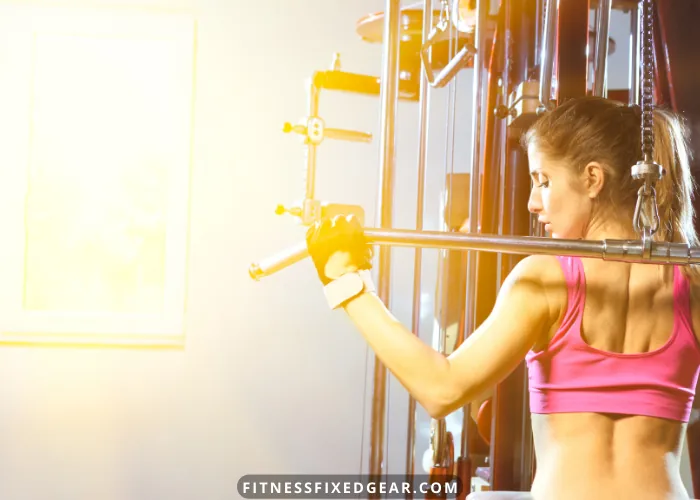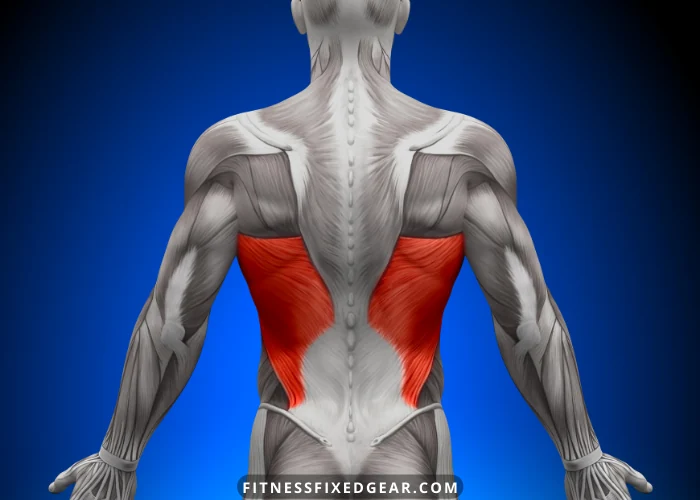Lat pulldowns are a stellar exercise to strengthen the muscles of your back. Whether you're trying to master pull ups or just want a ripped back, the lat pulldown is your friend.
But it does come with some potential limitations. What if you don't have access to a lat pulldown machine?
Or what if you're stuck or have slowed in your progress?
Enter the lat pulldown alternative exercises in this article! We'll cover the best lat pulldown alternatives with dumbbells, barbells, and more. Let's dig in.
The 14 Best Lat Pulldown Alternatives are:
- Chin Ups
- Pull Ups
- Machine Lat Pullover
- Single Arm Dumbbell Rows
- Dumbbell Pullovers
- Single-Arm Pulldowns
- Straight-Arm Pulldowns
- Barbell Rows
- T-Bar Rows
- Incline Dumbbell Rows
- Seated Low Cable Rows
- Inverted Rows
- Renegade Rows
- Barbell Pullovers
What Makes the Lat Pulldown a Great Exercise?
Lat pulldowns work your upper body muscles in a static, seated position.

That means you really zero in on the muscle groups you're targeting (more on those muscles below), getting the most bang for your buck.
Pulldowns help improve your posture and can get you closer to achieving the elusive yet impressive chin ups or pull ups.
TL;DR: Lat pulldowns boost upper body strength and can get you closer to chin ups and/or pull ups.
What Makes a Great Lat Pulldown Alternative?
If you don't have access to a lat pulldown machine, don't panic.
You can still get solid muscle work from a lat pull alternative.

The most effective lat pulldown alternatives will focus mostly on the latissimus dorsi muscles, but with a healthy dose of rhomboids, biceps brachii, and triceps for good measure.
So whether you do body weight moves, just dumbbells, or prefer barbell lifts, there's a lat pulldown alternative for you.
TL;DR: A great lat pulldown alternative will work the same muscles as a lat pulldown.
Muscles Worked in a Lat Pulldown
Not surprisingly, the lat pulldown exercise works, well, your lat muscles.
What are your lats?

Also known as latissimus dorsi, these are large muscles that begin just underneath your armpit and extend to your spine and down to your lower back.
These upper back muscles are important for good posture, plus stabilizing the neck, shoulder, back, and even the hips. If you want solid core muscle development, you need more lat engagement.
In addition to the lats, pulldowns work your rhomboids (small back muscle connecting your upper lats to your spine), both your biceps, and triceps.
TL;DR: For strong, powerful back muscles, include lat pulldowns (or a lat pulldown alternative or two) in your workout routine.
The 14 Best Lat Pulldown Alternatives
1. Chin Ups
It's no secret that one of the best way to work your lats is by doing chin ups.
A chin up, when done with proper form, is an incredible upper body strength exercise, and all you need is a chin up bar.
They make affordable ones you can hang in your doorway and slightly pricier ones that are separate pieces of exercise equipment.
A few key notes: a lot of people try to use momentum to get themselves over the bar, and/or strain their neck to crane their chin over so they've "completed" a rep. Avoid this.
Also, try to keep your whole body in a "hollow hold," meaning keep all your muscles engaged so your body forms a slight "c" shape. Don't let your lower body flop all around during your chin ups.
Equipment Needed
How To:
- Approach the bar either by stepping on a box or jumping up. Begin in a full hang, palms facing you, arms extended (but elbows not locked) with your entire body tight, forming that C-shape.
- Exhale and initiate the lift by doing scapular pull, meaning imagine tucking your shoulder blades into the opposite back pocket of your pants. Once your lats are fully engaged, lift yourself the rest of the way up, aiming your sternum toward the bar.
- Inhale as you lower back into starting position.
Pro Tip:
Can't do chin ups yet? Use a resistance band or practice the negative (lowering) part of the move first to build lat and trap strength.
Shoulder mobility is also key, so if that's holding you back from getting over the bar, prioritize mobility work.
2. Pull Ups
To kill your pull ups, you'll need a pull up bar (similar to the chin up version).
Pull ups differ from chin ups in one key way: hand placement. In a chin up, your palms face you in an underhand grip and your hands are slightly closer than shoulder width apart.
In a pull up, your hands face away from you in an overhand grip and are wider than your shoulders. Both both moves are stellar bodyweight exercises to build muscle.
Equipment Needed:
How To:
- Follow the same steps as a chin up, except keep your hands in a wide grip and palms facing away from you for proper pull up form.
Pro Tip:
Pull ups are hard. Like, really hard for some people. To get to your first pull up, follow the progressions in the video above.
You can also assist your pull ups with a resistance band, but don't get too used to doing that. Use the progressions to build strength instead.
3. Machine Lat Pullover
This is a great isolation movement if you have access to exercise machines. A machine lat pullover is different than a lat pulldown machine, but also zeros in on your lat muscles.
Equipment Needed:
- Lat pullover machine
How To:
- Sit in the machine with your back pressed fully into the rest. Place your elbows on the pads and grip the bar over your head.
- Exhale as you pull the bar down toward your lap. Keep your chest up but don't arch your back.
- Inhale to release the bar back over your head. Don't just let it fly up — make it a slow and controlled movement.
Pro Tip:
Keep your abs/core engaged throughout the movement to maintain proper torso position.
4. Single Arm Dumbbell Rows
Single arm dumbbell rows are a killer way to work your lats.
Using a single dumbbell means your balance is challenged so your core has to work a little harder.
Plus, you can really zero in on strengthening a single arm at a time (also known as a unilateral exercise).
Equipment Needed:
How To:
- Brace the knee and palm of your non-working side on the bench. Extend the other leg slightly behind you to brace so you can lower the working single arm without obstruction.
- Pick up the dumbbell. Maintain a neutral spine with core engaged. Exhale to lift the bell toward your chest in a rowing motion, so your elbow extends slightly above your back. Focus on pulling your shoulder blade in toward your spine.
- Pause for a moment at the top before inhaling as you lower the bell back to starting position.
Pro Tip:
To make this an effective lat pulldown alternative, do lower reps with lighter weight so you can really zero in on those lats.
5. Dumbbell Pullovers
Traditionally, dumbbell pullovers target your chest. But with a slight tweak — flaring your elbows — they become stellar lat pulldown alternatives.
Work the dumbbell pullover into your routine as an alternative exercise to the lat pulldowns.
Equipment Needed:
How To:
- Lay flat on your back on your bench and kick the dumbbell into position with your thigh. With your hands in a triangle shape around the handle of the bell, hold it over your chest with straight elbows.
- Exhale as you flare your elbows and lower the weight over your head. Try to keep the weight as close to your body as possible (watch out that you don't hit yourself in the head).
- Inhale to lift the weight back to starting position.
Pro Tip:
To up the intensity, try a decline dumbbell pullover. Decline dumbbell pullovers work your lats, triceps, and chest more than the regular ones, thanks to the extra gravity of the decline.
6. Single-Arm Pulldowns
This lat pulldown movement does use a lat pulldown machine, but you can also use a cable machine if you have access to that. You're basically doing a lat pulldown but with only one arm.
Equipment Needed:
How To:
- Load a lighter weight in the machine than you ordinarily would. Sit on the bench and grasp the bar or pulleys in your working hand.
- With core braced and feet flat, lean back slightly (this helps target your lats as opposed to your biceps brachii). Exhale as you pull the bar down with one hand, thinking about your elbow tucking in and engaging those lats.
- Inhale to release the weight back up.
Pro Tip:
This is a zeroed in movement, meaning it's hard to "cheat" your reps. Save them for the beginning of your workout when your energy and intensity is high.
7. Straight-Arm Pulldowns
Got another machine exercise for you here, folks. A straight arm pulldown is a lat pulldown exercise that uses the same muscles as a regular pulldown, just in a different form.
Equipment Needed:
How To:
- Grasp the bar and take few steps away from the machine. Lean forward at about a 30º angle. Your arms should be fully extended with a slight bend in your elbows.
- Tighten your lats. Exhale and, keeping your arms straight, pull the bar down by contracting your lats until your hands are beside your thighs.
- Inhale to return to start.
Pro Tip:
Make sure your torso angle stays consistent so you're working through the same range of motion on each rep.
8. Barbell Rows
Barbell rows are great lat pulldown alternatives because they target the same muscles that a lat pulldown works.
Plus, if you don't have access to machines but have barbells, you can keep working those back muscles.
Equipment Needed
How To:
- Approach the bar like you would a deadlift: bar over the middle of your foot, overhand grip, core braced. Maintain a neutral spine to deadlift the bar up. Keeping proper form, lower the bar so it's just below your knees. Keep elbows, wrists, and shoulders in line. This is your starting position.
- Exhale to lift the bar toward your torso in a straight line. It will make contact with your trunk, just keep your shoulders all the way back and squeezed.
- Inhale to lower the bar back down.
Pro Tip:
Respect the weight on the bar and keep your core engaged throughout to protect your lower back.
9. T-Bar Rows
The T-bar row is a classic back-building exercise. Add it to your list of rowing exercises to take the place of your lat pulldowns any day.
Equipment Needed:
How To:
- With barbell anchored, straddle the bar and place your grip around the bell (if using, can also just grip the bar). Deadlift the barbell into position, just below your knees, hands barely brushing your knee joint.
- With knees bent, hips back, and torso tall, exhale to pull the barbell inward, retracting your scapula completely. Hold for a moment at the top.
- Inhale as you lower the bar back down.
Pro Tip:
Make sure your spine is fully extended and neutral, core engaged. Don't round your upper body during your reps.
10. Incline Dumbbell Rows
Doing static dumbbell rows is great, but doing them on an incline isolates the muscles in your back and eliminates any possible momentum or lower back pain if your form isn't 100% spot on. Use an incline dumbbell row if you're building form to doing them without an incline bench.
Equipment Needed:
- Incline bench
- Dumbbells
How To:
- Set your bench incline anywhere from 40–70º. Lay with your chest on the bench and a dumbbell in each hand. You can use a neutral or underhand grip.
- Before your rep, engage/contract your lats/scapula muscles. Exhale as you lift the dumbbells, focusing on pulling your shoulder blades back and together, elbows high.
- Inhale to slowly lower back down and repeat.
Pro Tip:
To focus on the lats, try an underhand grip.
11. Seated Low Cable Rows
Seated low cable rows are stellar rowing exercises to replace lat pulldowns. They primarily work your lats and rhomboids, so you can build muscle in your back.
Equipment Needed:
How To:
- Load the machine with a weight appropriate to your strength. Sit in the machine, grab the handles, and push yourself back so you have a slight bend in your knees. Make sure your shoulders are back and down and your chest slightly pushed out so you have a gentle arch in your spine.
- Exhale and use your back muscles to bring your hands to your torso. At the top of the movement, keep everything in your core tight and engaged.
- Inhale as you slowly release the weight back to starting position.
Pro Tip:
Pull your elbows narrower and lower than you ordinarily would to really dial in on those lats.
12. Inverted Rows
Inverted rows are an amazing body weight exercise that's going to target your upper back. Plus, because you're fighting gravity and engaging your core throughout, it's almost a compound exercise. Win-win.
Equipment Needed:
- Smith machine loaded down with weight
- Rings attached to something sturdy
- Any horizontal bar that's low to the ground really
How To:
- Lay down beneath your bar of choice. You should be able to reach the bar without your body touching the ground. Dig your heels into the ground and hold the bar with grip slightly wider than shoulder width.
- Keep your body straight, like a plank. Maintain this neutral spine as you exhale and lift your chest toward the bar.
- Inhale to slowly lower yourself back down.
Pro Tip:
If these are too difficult, you can raise the bar so you're not fully horizontal. Or, you can scoot yourself up a bit so you're again less horizontal.
13. Renegade Rows
This is a version of a dumbbell row that's not for the faint of heart. This rowing exercise combines a plank with a row movement, so make sure to master the regular dumbbell row first.
Equipment Needed:
How To:
- Grab a lighter dumbbell (or a pair of them for extra challenge) and get into a plank position. Key points: keep your shoulders directly over your wrists and your feet spread wide.
- If using one dumbbell, keep the non-working hand flat on the ground. Exhale and keep your core tight as you row the dumbbell back (not up) meaning focus on driving your elbow toward your lower ribs. Make sure your hips and shoulders stay square.
- Inhale to lower the dumbbell back toward the ground and repeat.
Pro Tip:
For that extra challenge, balance on a dumbbell in each hand and take turns rowing either side.
14. Barbell Pullovers
Our final lat pulldown alternative is the barbell pullover. It's similar to a dumbbell pullover except, well, you use a barbell.
Equipment Needed:
- Barbell
How To:
- Load a barbell with light weight. Lay back on a bench with your legs on either side and the barbell over your chest. Use an overhand grip with hands about shoulder width apart.
- Keep your core braced and feet flat. Exhale and evenly lower the weight over your head, keeping your arms straight (a gentle bend in the elbows is fine).
- Inhale to lift the weight back over your chest.
Pro Tip:
If pullovers are old hat to you, instead of lying completely braced on your flat bench, try only bracing your shoulders so the rest of your torso is in the air. Caution: you need a lot of solid core strength for this, so only attempt it after you've built up to it.
Conclusion
I hope you've enjoyed this list of alternatives to lat pulldown exercises!
Whether you want to try resistance band lat pulldowns, some of the barbell options we've listed, or the pulldown alternatives with dumbbells, all of these exercises will get you a jacked back.
So never fear if you don't have access to a lat pulldown machine — just bookmark this article and work these moves into your next back day!

